APT and SIMS in Geology and Geoscience
How APT (Atom Probe Tomography) and SIMS can be used in the fields of geology and geoscience, with examples from geochronology, mining and meteorite research.
Virtual Conference: Geology for Renewable and Sustainable Energy
Thursday 26th November 2020, 10:30am GMT (3 hours)
Discover a wide range of analytical techniques for geology in the field of green energy at our online conference. Watch a recording of the talks..
Blue Scientific is the official distributor for CAMECA APT and SIMS instruments in the UK and Finland. For more information or quotes, please get in touch.
View the CAMECA range
More articles about geoscience
Contact us on +44 (0)1223 422 269 or info@blue-scientific.com
Elemental and Isotopic Microanalysis
Elemental and isotopic microanalysis can be used for a range of applications in geology and geoscience, to study stable and radiogenic isotopes, as well as both light and heavy elements in complex minerals and phases:
- Geo and cosmochemistry
- Mineralogy and petrography
- U-Th-Pb geochronology
- Paleoclimate and early earth studies
- Locate ore deposits
- Predict volcanic eruption
- … and more
Atom Probe Tomography
Atom Probe Tomography (APT) is the only materials analysis technique offering extensive capabilities for both 3D imaging and chemical composition measurement at the atomic scale.
- Single atom detection
- 3D tomographic data with near-atomic spatial resolution
- Equal sensitivity to all elements and their isotopes
- Quantitative composition measurement (sub-nm to micrometer scale)

SIMS
SIMS is the most sensitive elemental and isotopic surface microanalysis technique. Static SIMS focuses on the top monolayer, and dynamic SIMS investigates bulk composition and in-depth distribution of trace elements, with a depth resolution from sub-nm to tens of nm.
- Extremely high sensitivity to all elements from Hydrogen to Uranium and above
- Detection limit down to ppb level for many elements
- High lateral resolution imaging down to 40 nm
More about SIMS and how it works…
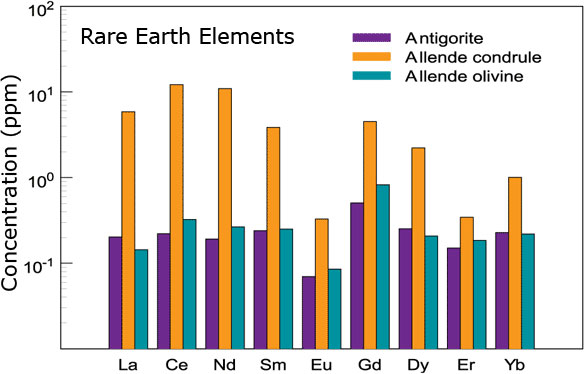
Example Applications
APT and SIMS have varied applications in geology and geoscience. These are just a few examples – if your area of interest isn’t mentioned, please contact us for information about how they can be used in other areas.
Target Mining Locations
Microanalysis techniques can be used to help optimise discovery and extraction in the mining industry. SIMS analysis can indicate the optimum mining locations for the best return on investment.
For example, in the gold industry, ore quality has been decreasing over the last 20 years. Four times more ore is now processed to produce the same amount of gold. Knowing the microscopic details of the chemistry and gold distribution in ore is key to maximising profit.
The example below shows representative pyrite from a Lannigou gold deposit sample. Three main stages can be distinguished by Au-As concentration and texture:
- Pre-ore stage equal to pyrite core forming.
- As precipitated without Au.
- Main Au precipitation stage. Two periods in stage 3 are divided by the line scan character of gold and arsenic. (White arrow = path of the line scan).
This was measured using the CAMECA NanoSIMS 50L, a dynamic SIMS instrument with a ~50nm spot size for both negative and positive secondary ions to produce high spatial resolution imaging capability. Up to seven elements or isotopes can be detected in parallel with ultra-high sensitivity, high mass resolving power and excellent lateral imaging resolution.
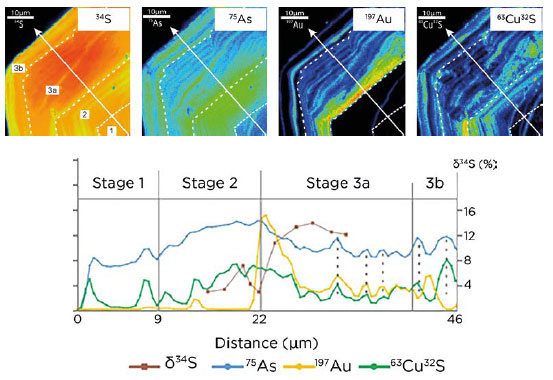
In the example below, the CAMECA LEAP Atom Probe was used to find ‘invisible’ gold in refractory minerals (arsenopyrite). It provides precise information about the position and type of individual atoms. This data is then converted into a 3D image.
Compared to other microanalytical methods that are used to identify fruitful regions within minerals, Atom Probe Tomography is uniquely capable of revealing the atomic-scale distribution of the atoms. In some regions, they may be clustered in domains measuring just a few nanometres in size, while in other regions, they may be distributed homogenously. From grain to grain the concentration could vary by an order of magnitude.
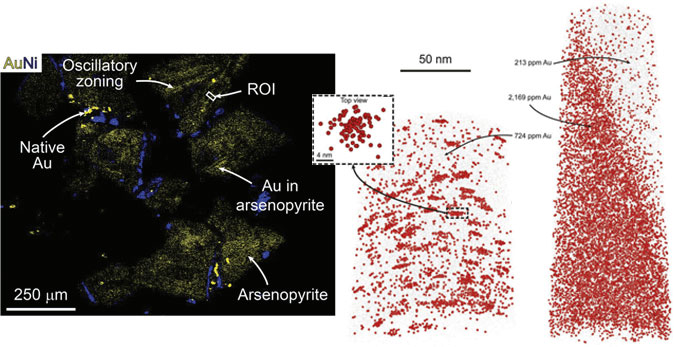
Data from Fougerouse, D., S. M. Reddy, D. W. Saxey, W. D. A. Rickard, A. van Riessen, and S. Micklethwaite (2016), Nanoscale gold clusters in arsenopyrite controlled by growth rate not concentration: Evidence from atom probe microscopy, American Mineralogist, 101(8), 1916, doi:10.2138/am-2016-5781CCBYNCND.
Water in Earth’s Mantle
In-situ isotopic and elemental information from mineral samples can provide insights into the water in the Earth’s mantle, in the form of hydrogen bonded to the silicate’s structural oxygen. Analysing mineral inclusions encapsulated hundreds of kilometers down within the mantle provides information about the amount of water that exists, its distribution and where it comes from.
The CAMECA IMS 7f-GEO is a mono-collection SIMS system specifically designed for precise, high throughput measurements on geological samples (stable isotopes and trace elements). It delivers high quality data, with low detection limits for light elements.
Meteorites
Meteorites can provide information about our early solar system and its evolution. For example, refractory inclusions in chondritric meteorites contain records of high temperature processes that took place in the early solar system.
SIMS provides extremely precise isotopic ratio analyses that can be used to shed light on the early evolution of the solar system. It can be used to determine isotopic variations between samples from different regions.
The CAMECA IMS 1300-HR³ ion microprobe performs fast, high precision isotope analysis, with high density cesium ion bombardment and isotopic multi-collector system. Even if only limited amounts of a sample are available, small spot sizes from 10μm down to <1μm can be used to characterise isotope systematics on a fine scale.
Case study: SIMS Meteorite Research Reveals the Origin of Water on Earth
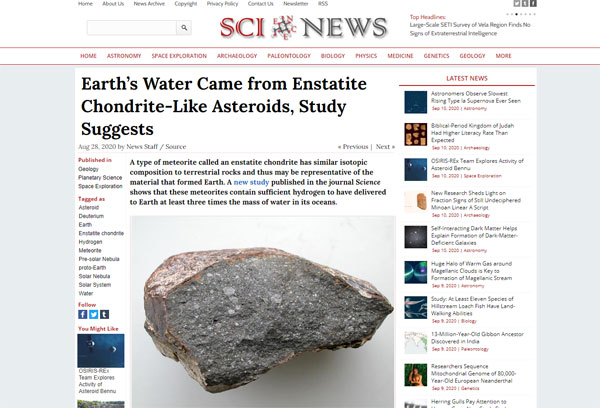
Geochronology
Measuring certain elements with known isotopic decay rates (eg Pb, U, Th), often located in nanoclusters, can provide useful information for geochronology. APT can be used to measure isotopic composition in nanoclusters in three dimensions, together with accurate chemical identification. It’s especially suited to characterising composition variations from the microscale to the sub-nanoscale.
The example below shows representative clusters from discordant 2.1 Ga zircon. Clustered Pb atoms (green) are shown without co-clustering of U atoms (yellow). The table shows the Pb isotope ratio analyses.
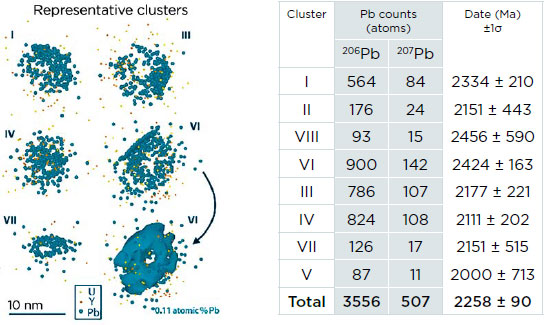
NanoSIMS in Geology
Watch this 13 minute video from CAMECA for an overview of nanoSIMS applications in geology, from mining to battery development:
More Information
Blue Scientific is the official distributor for CAMECA in the UK and Finland. We’re available to provide quotes and advice – just get in touch:


